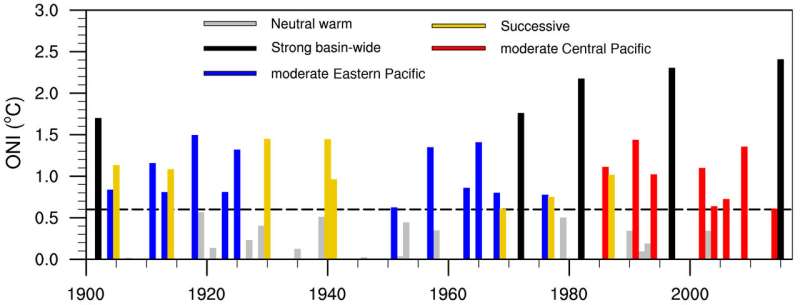Climate warming promises more frequent extreme El Niño events

El Niño events cause serious shifts in weather patterns across the globe, and an important question that scientists have sought to answer is: how will climate change affect the generation of strong El Niño events? A new study, published today in the Proceedings of the National Academy of Science by a team of international climate researchers led by Bin Wang of the University of Hawaii's International Pacific Research Center (IPRC), has an answer to that question. Results show that since the late 1970's, climate change effects have shifted the El Niño onset location from the eastern Pacific to the western Pacific and caused more frequent extreme El Niño events. Continued warming over the western Pacific warm pool promises conditions that will trigger more extreme events in the future.
The team examined details of 33 El Niño events from 1901 to 2017, evaluating for each event the onset location of the warming, its evolution, and its ultimate strength. By grouping the common developmental features of the events, the team was able to identify four types of El Niño, each with distinct onset and strengthening patterns. Looking across time, they found a decided shift in behavior since the late 1970's: all events beginning in the eastern Pacific occurred prior to that time, while all events originating in the western-central Pacific happened since then. They also found that four of five identified extreme El Niño events formed after 1970.
Wang and his co-authors focused on the factors that seemed to be controlling these shifts, including increased sea surface temperatures in the western Pacific warm pool and the easterly winds in the central Pacific, and found that with continued global warming, those factors may lead to a continued increase in frequency in extreme El Niño events.
"Simulations with global climate models suggest that if the observed background changes continue under future anthropogenic forcing, more frequent extreme El Niño events willinduce profound socioeconomic consequences," reports Wang.
Past strong El Niño events have caused severe droughts in the western Pacific Islands and Australia, leading to extensive wildfires and famine, while dangerous flooding from excessive rainfall have plagued northern coasts of South America. Warm ocean temperatures associated with the events have also generated strongly negatively effects on fisheries and coral reefs, globally.
The classification system derived in this study provides an important tool for improvement in climate modeling of El Niño and La Niña events. Wang's research group plans to explore further how this work may help improve predictions of future El Niño events. A better understanding of how these events may change over time will help adaptation efforts to mitigate their economic, environmental, and societal impacts.
More information: Historical change of El Niño properties sheds light on future changes of extreme El Niño, Proceedings of the National Academy of Science (2019). DOI: 10.1073/pnas.1911130116
Journal information: Proceedings of the National Academy of Sciences
Provided by University of Hawaii at Manoa




















